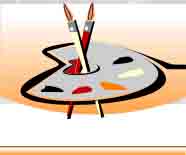HELENSBURGH has an active and flourishing art club, and the number of active amateur artists is increasing all the time.
The history of the club is bound up with the story of Helensburgh from when it was developed by Sir James Colquhoun of Luss, who sold plots of land to build large houses, culminating in the completion of Hill House in 1902.
Glasgow was very modern for its day, taking an interest in the new art from Europe. Dealers like Alex Reid brought 'Pleine Air' art to Glasgow — that is paintings executed outside from nature of life as it was, not the large historical and mythological pictures that were painted in studios which were current at that time.
The Impressionists also found a market in Glasgow, and much art was bought for these fine houses in the Helensburgh area. Some of the 'Glasgow Boys' worked in studios in Helensburgh, including W.Y.MacGregor, Lavery, Guthrie and Walton.
There was an art club in Helensburgh between the two World Wars, with exhibitions in the Granary building on Clyde Street at the foot of Sinclair Street. Many of the artists who exhibited there were determined to form the Helensburgh and District Art Club.
The first committee meeting was held in 1951, and among the first members were Charles Taylor, Gregor Ian Smith, Elspeth Beaton, J.Carlaw, May Howison and James D.Burgess.
They were lucky to have on the committee Harry Jefferson Barnes (later Sir Harry), who was director of the Glasgow School of Art and who brought a constant stream of talented practising artists, including Hugh Adam Crawford and Benno Schotz, to give lectures and demonstrations to the club members
The format then was much as it is today — lectures, workshops, demonstrations, exhibitions, Christmas dinner or social evening, and visits to the Art School and to exhibitions in Glasgow and Edinburgh. The portrait class has always been popular, and eventually a junior class was formed.
From the beginning the club has search for permanent premises, but this has never been achieved. Meetings have been held in various venues, including church halls, and for a long time the Clyde Community Centre was used until it was closed in 2004. The current meeting venue is Helensburgh Lawn Tennis Club on Suffolk Street.
Exhibitions are usually housed in the Victoria Halls, but sometimes in Helensburgh Library or St Columba Church Hall.
For a long time from the formation, Miss A.T. (Nance) Anderson was Honorary President, and when she died in 1976 she left her collection of Helensburgh pictures, mostly by local artists, to a trust called the Anderson Trust. The trust has added to the collection, and holds regular exhibitions, usually in the Library.
The first president, for three years, was Charles Taylor, and then the man who was the backbone of the club, Gregor Ian Smith, held that office for 22 years. There have been 13 presidents since, serving from two to five years. The first annual subscription was 25p.
There have been many notable exhibitions over the years. Included in the 1954 exhibition were pictures owned by Helensburgh residents. There were works by Raeburn, Ramsay, Peploe, Cadell, Guthrie, Hunter, Hornel, Toulouse Lautrec, Fantin-Latour, Crawhall and Edward Lear. In 1956 four Glasgow artists, Joan Eardley, Margot Sandeman, Sinclair Thomas and William Crosbie, were invited to participate.
Around this time another local artist, Ailsa Tanner, became a key figure, arranging many fine outside exhibitions.
One was the Helensburgh and Glasgow School in 1964. The 1971 exhibition included three Kilbarchan artists, Tom Shanks, Cynthia Wall and William Birnie. Two years later the featured artists were Guthrie, Whitelaw Hamilton, Walton, James Paterson and John Lavery, who all painted in Helensburgh.
The 1976 exhibition included works by the 'Glasgow Girls', including Norah Nelson Grey, who painted World War One scenes, Jessie King, and Ailsa Tanner's mother, Eleanor A.Moore.
From 1996 to date, the club has been involved in exchanges with Helensburgh's twin town, Thouars.
 The club took part in the Millennium Visual Arts Festival, a summer programme of events and workshops, funded by the National Lottery. In 2002 the club took part in the Helensburgh Bicentenary celebrations, and in the nextt three years the Lomond and Clyde Springfest (originally called the Helensburgh Blossom Festival).
The club took part in the Millennium Visual Arts Festival, a summer programme of events and workshops, funded by the National Lottery. In 2002 the club took part in the Helensburgh Bicentenary celebrations, and in the nextt three years the Lomond and Clyde Springfest (originally called the Helensburgh Blossom Festival).
Many distinguished artists have lectured and demonstrated, including Alberto Marrocco, Emilio Coia, Richard De Marco, Jean Irwin, James Robertson, Alexander Goudie, John Millar, Anda Paterson, James Fullerton, Robert Kelsey, Norman Kirkam, Hamish MacDonald, Rodger Billcliff and Cordelia Oliver, to name but a few.
A wonderful band of loyal members have supported the club over long years and made it what it is today. The average membership is 210.
The club hopes to encourage would-be artists to 'have a go', to give a platform for artists to exhibit their work at every level of achievement, and to help those who do not paint but who love art to have a better understanding.